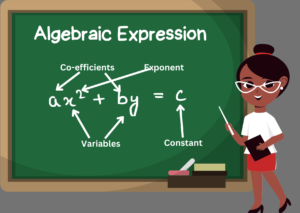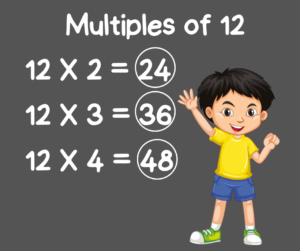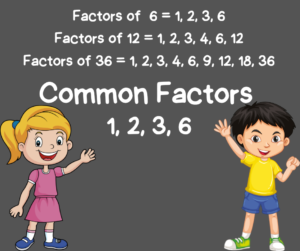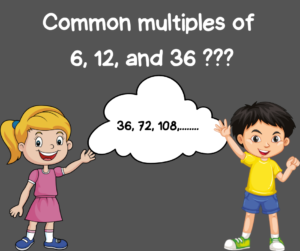Introduction
An expression made up of variables, constants, coefficients, and mathematical operations like addition, subtraction, etc. is known as an algebraic expression. A variable is a symbol without a predetermined value. In an algebraic expression, a symbol with a fixed numerical value is referred to as the constant. A term is either a variable, a constant, or both combined through mathematical operations. A coefficient is a quantity that has been multiplied by a variable and is constant throughout the entire problem. Algebraic expressions have many uses, including representing real-world issues as well as solving various and complex mathematical equations to determine revenue, cost, etc.
Algebraic Expressions
An expression made up of variables, constants, coefficients, and mathematical operations like addition, subtraction, etc. is known as an algebraic expression. Algebraic expressions have many uses, including representing real-world issues and solving various and complex mathematical equations, finding revenue, cost, etc.
Based on a variety of number of terms, there are three main categories of algebraic expressions, i.e., monomial, binomial, and polynomial.
What is a Term in Algebra
A term is a group of numbers or variables that have been added, subtracted, divided, or multiplied together; a factor is a group of numbers or variables that have been multiplied; and a coefficient is a number that has been multiplied by a variable. Three terms, 9x², x, and 12, make up the expression 9x² + x + 12.
By drawing this conclusion, it is clear that an expression is made up of a number of terms, variables, factors, coefficients, and constants.
Terms of an Expression
A term can be a number, a variable, the sum of two or more variables, a number and a variable, or a product of both. A single term or a collection of terms can be used to create an algebraic expression. For instance, 2x and 5y are the two terms in the expression 2x + 5y.
A mathematical expression has one or more terms. A term in an expression can be a constant, a variable, the product of two variables (xy) or more (xyz), or the product of a variable and a constant (2x), among other things.
Different types of terms in an Algebraic Expression
There are different types of terms in algebraic expressions,

Variables
These types of terms are usually represented by a symbol (most commonly its English alphabets), like x, y, z, a, b, etc. these symbols are there to represent unknown arbitrary values, hence the name ‘variables’ (since their values can vary).
Coefficient
These are not a type of a term but rather a part of a term that contains variables, coefficients are the numbers that are in multiplication with variables.
Constants
These terms are the numbers separate from the variables, and as the name suggest, they are a constant number, i.e., they are fix and never change unless they are under an operation with another constant term.
Also Read: Like and Unlike Terms
Algebraic Expressions Based on Number of Terms
A single term or a number of terms can be used to create an algebraic expression. Based on the number of terms, there are various types of expressions. These are listed below:
- Monomial Expressions: – An algebraic expression in which an expression has only one term is known as a monomial. For example, 3x, xyz, x²
- Binomial Expression: – An algebraic expression in which an expression has two terms is known as a monomial. For example, 5x + 8, xyz + x³
- Polynomial Expression: – An expression in which an expression has more than two-term within a variable is known as a polynomial. For example, 2x + 4y + 7z, x² + 5x + 3
Factors of terms: Identifying Factors
Factorization of terms refer to an algebraic expression that is written as a multiple of variables and constants.
We will now determine the factors of the terms in the given expression. To do this, we must first separate the terms and then look for their multiples. The results of this process are the factors of the given expression.
Let the expression be,
3xy + 5z²
Then the terms are,
3xy, 5z²
And the factorization of the terms are,
3 × 𝑥 × y and 5 × z × z
Solved Examples
Example 1: Identify the different terms, variables and coefficients in the following expressions
a. x² + 3xy
b. 2ab + 5c²
Solution:
a. Expression: x² + 3xy
Terms: x², 3xy
Variables: x, y
Coefficients: 1 for x², 3 for xy
b. Expression: 2ab + 5c²
Terms: 2ab, 5c²
Variables: a, b, c
Coefficients: 2 for ab, 5 for c²
Summary
An expression made up of variables, constants, coefficients, and mathematical operations like addition, subtraction, etc. is known as an algebraic expression. Coefficients, constants, and variables are a few of the key words in the context of algebraic expressions. Similar terms are those in algebraic expressions that are constants or involve similar variables raised to similar exponents. In algebraic expressions, unlike terms are those terms that do not share the same variables or that share the same variables but have different exponents. Algebraic expressions are all polynomials, but not all algebraic expressions are polynomials. Polynomials are algebraic expressions without fractional or non-negative exponents. Algebraic expressions include fundamental identities that are used in the subject.
FAQs
1.What are Polynomials?
Ans. Polynomials are algebraic expressions with more than 2 terms and the variables have non-negative integer exponents.
2.What is a Quadratic Equation?
Ans. A quadratic equation is a polynomial equation, with maximum exponent on a variable being 2.
3. What is a term in an Algebraic Expression?
Ans. A term can be a number, a variable, the sum of two or more variables, a number and a variable, or a product of both. A single term or a collection of terms can be used to create an algebraic expression.



